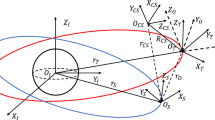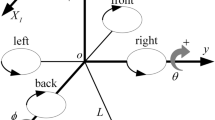Abstract
In this paper, the problem of attitude stabilization control of spacecraft under angular velocity constraint is investigated. A state-constrained finite-time attitude control scheme is designed by making full use of the model feature of the quaternion. Based on the homogeneous domination approach, the finite-time stability of the closed-loop system is proved. It proves that the angular velocity can be constrained within the limited range at any time. For the attitude loop dynamics subsystem with external disturbances, based on a radial basis function neural network, an integral terminal sliding mode controller is proposed. Finally, the validity and advantages of the proposed control scheme are demonstrated in the simulation section compared with the other two control methods.





Similar content being viewed by others
References
Gui H, Vukovich G (2017) Finite-time angular velocity observers for rigid-body attitude tracking with bounded inputs. Int J Robust Nonlinear Control 27(1):15–38
Du H, Zhang J, Wu D, Zhu W, Li H, Chu Z (2020) Fixed-time attitude stabilization for a rigid spacecraft. ISA Trans 98:263–270
Cong Y, Du H, Jin Q (2020) Formation control for multiquadrotor aircraft: connectivity preserving and collision avoidance. Int J Robust Nonlinear Control 30(6):2352–2366
Krstic M, Tsiotras P (1999) Inverse optimal stabilization of a rigid spacecraft. IEEE Trans Autom Control 44(5):1042–1049
Park Y (2005) Robust and optimal attitude stabilization of spacecraft with external disturbances. Aerosp Sci Technol 9(3):253–259
Gasagrandea D, Astolfi A, Parisini T (2008) Global asymptotic stabilization of the attitude and the angular rates of an underactuated non-symmetric rigid body. Automatica 44(7):1781–1789
Jiang B, Lu J, Liu Y, Cao J (2020) Periodic event-triggered adaptive control for attitude stabilization under input saturation. IEEE Trans Circuits Syst I(67):249–258
Cai M, Xiang Z (2018) Adaptive finite-time control of a class of non-triangular nonlinear systems with input saturation. Neural Comput Appl 29:565–576
Wang F, Hou M, Cao X (2019) Event-triggered backstepping control for attitude stabilization of spacecraft. J Frank Ins Eng Appl Math 356(16):9474–9501
Wang X, Li S, Chen M (2018) Composite backstepping consensus algorithms of leader-follower higher-order nonlinear multiagent systems subject to mismatched disturbances. IEEE Trans Cyber 48(6):1935–1946
Wang H, Mi C, Cao Z, Zheng J, Man Z, Jin X, Tang H (2020) Precise discrete-time steering control for robotic fish based on data-assisted technique and super-twisting-like algorithm. IEEE Trans Ind Electron 67(12):10587–10599
Zhang J, Wang H, Ma M, Yu M, Yazdani A, Chen L (2020) Active front steering-based electronic stability control for steer-by-wire vehicles via terminal sliding mode and extreme learning machine. IEEE Trans Veh Technol 69(12):14713–14726
Hu Y, Wang H, He S, Zheng J, Ping Z, Shao Ke, Cao Z, Man Z (2021) Adaptive tracking control of an electronic throttle valve based on recursive terminal sliding mode. IEEE Trans Veh Technol 70(1):251–262
Zhang J, Wang H, Zheng J, Cao Z, Man Z, Yu M, Chen L (2020) Adaptive sliding mode-based lateral stability control of steer-by-wire vehicles with experimental validations. IEEE Trans Veh Technol 69(9):9589–9600
Zhang J, Wang H, Cao Z, Zheng J, Yu M, Yazdani A, Shahnia F (2019) Fast nonsingular terminal sliding mode control for permanent magnet linear motor via ELM. Neural Comput Appl 32:14447–14457
Chen L, Wang H, Huang Y, Ping Z, Yu M, Ye M, Hu Y (2020) Robust hierarchical terminal sliding mode control of two-wheeled self-balancing vehicle using perturbation estimation. Mech Syst Sig Process. https://doi.org/10.1016/j.ymssp.2019.106584
Ding S, Liu L, Park J (2019) A novel adaptive nonsingular terminal sliding mode controller design and its application to active front steering system. Int J Robust Nonlinear Control 29(12):4250–4269
Hu Y, Wang H (2020) Robust tracking control for vehicle electronic throttle using adaptive dynamic sliding mode and extended state observer. Mech Syst Sig Process 135:1–18
Ning B, Han Q, Zuo Z (2019) Practical fixed-time consensus for integrator-type multi-agent systems: a time base generator approach. Automatica 105:406–414
Ding S, Park J, Chen C (2020) Second-order sliding mode controller design with output constraint. Automatica 112:1–8
Ning B, Han Q, Zuo Z, Jin J, Zheng J (2020) Collective behaviors of mobile robots beyond the nearest neighbor rules with switching topology. IEEE Trans Cybern 48(5):1577–1590
Wang K, Liu X, Jing Y (2020) Robust finite-time \(H_{\infty }\) congestion control for a class of AQM network systems. Neural Comput Appl. https://doi.org/10.1007/s00521-020-05168-z
Du H, Cheng Y, Wen G, Lv J (2021) Design and implementation of bounded finite-time control algorithm for speed regulation of permanent magnet synchronous motor. IEEE Trans Ind Electron 67(3):2417–2426
Hu Y, Wang H, Cao Z, Zheng J, Ping Z, Chen L, Jin X (2019) Extreme-learning-machine-based FNTSM control strategy for electronic throttle. Neural Comput Appl 32:14507–14518
Du H, Wen G, Wu D, Cheng Y, Lu J (2020) Distributed fixed-time consensus for nonlinear heterogeneous multi-agent systems. Automatica 113:1087–1097
Ding S, Mei K, Li S (2019) A new second-order sliding mode and its application to nonlinear constrained systems. IEEE Trans Automat Control 64(6):2545–2552
Wang X, Wang G, Li S (2020) Distributed finite-time optimization for integrator chain multiagent systems with disturbances. IEEE Trans Automat Control 65(12):5296–5311
Chen C, Sun Z (2020) Output feedback finite-time stabilization for high order planar systems with an output constraint. Automatica. https://doi.org/10.1016/j.automatica.2020.108843
Ding S, Park J, Tayebi Chen C (2020) Second-order sliding mode controller design with output constraint. Automatica. https://doi.org/10.1016/j.automatica.2019.108704
Zhu Z, Xia Y, Fu M (2011) Attitude stabilization of rigid spacecraft with finite-time convergence. Int J Robust Nonlinear Control 21(6):686–702
Du H, Li S (2012) Finite-time attitude stabilization for a spacecraft using homogeneous method. J Guid Control Dyn 35(3):740–748
Wie B, Lu J (1995) Feedback control logic for spacecraft eigenaxis rotations under slew rate and control constraints. J Guid Control Dyn 18(6):1372–1379
Shen Q, Yue C, Goh C, Wu B, Wang D (2018) Rigid-body attitude stabilization with attitude and angular rate constraints. Automatica 90:157–163
Sun L (2020) Adaptive fault-tolerant constrained control of cooperative spacecraft rendezvous and docking. IEEE Trans Ind Electron 67(4):3107–3115
Habibi H, Nohooji R, Howarda L, Simani S (2019) Fault-tolerant neuro adaptive constrained control of wind turbines for power regulation with uncertain wind speed variation. Energies 12:24. https://doi.org/10.3390/en12244712
Habibi H, Nohooji R, Howarda L (2019) Backstepping nussbaum gain dynamic surface control for a class of input and state constrained systems with actuator faults. Inf Sci 482:27–46
Shuster M (1993) A survey of attitude representations. J Astronaut Sci 41(4):439–517
Bhat S, Bernstein D (2000) Finite-time stability of continuous autonomous systems. SIAM J Control Opt 38(3):751–766
Bhat S, Bernstein D (1997) Finite-time stability of homogeneous systems. In: Proceedings of the American Control Conference. Albuquerque, NewMexico, 2513-2514
Hong Y, Huang J, Xu Y (2001) On an output feedback finite-time stabilization problem. IEEE Trans Automat Control 46(2):305–309
Hong Y, Xu Y, Huang J (2002) Finite-time control for robot manipulators. Syst Control Lett 46(4):185–200
Yu S, Yu X, Shirinzadeh B, Man Z (2005) Continuous finite-time control for robotic manipulators with terminal sliding mode. Automatica 41(11):1957–1964
Khalil H (2002) Nonlinear Systems. Prentice Hall, Upper Saddle River, NJ
Zhu W, Chen D, Du H, Wang X (2020) Position control for permanent magnet synchronous motor based on neural network and terminal sliding mode control. Trans Inst Meas Control 42(9):1632–1640
Tayebi A, McGilvray S (2006) Attitude stabilization of a VTOL quadrotor aircraft. EEE Trans Control Syst Technol 14(3):562–571
Zuo Z, Ru P (2014) Augmented \(L_1\) adaptive tracking control of quad-rotor unmanned aircrafts. IEEE Trans Aerosp Electron Syst 50(4):3090–3101
Zhao B, Xian B, Zhang Y, Zhang X (2015) Nonlinear robust adaptive tracking control of a quadrotor UAV via immersion and invariance methodology. IEEE Trans Ind Electron 62(5):2891–2902
Du H, Zhu W, Wen G, Duan Z, Lv J (2017) Distributed formation control of multiple quadrotor aircraft based on nonsmooth consensus algorithms. IEEE Trans Cybern 49(1):342–353
Author information
Authors and Affiliations
Corresponding author
Additional information
Publisher's Note
Springer Nature remains neutral with regard to jurisdictional claims in published maps and institutional affiliations.
This work is supported by National Natural Science Foundation of China under Grant Nos. 62073113, 62003122, 61673153, 61773216, Natural Science Foundation of Anhui Province of China under Grant Nos. 2008085UD03, 1808085MF180, and the Fundamental Research Funds for the Central Universities of China under Grant No. PA2020GDKC0016.
Rights and permissions
About this article
Cite this article
Yu, B., Du, H., Ding, L. et al. Neural network-based robust finite-time attitude stabilization for rigid spacecraft under angular velocity constraint. Neural Comput & Applic 34, 5107–5117 (2022). https://doi.org/10.1007/s00521-021-06056-w
Received:
Accepted:
Published:
Issue Date:
DOI: https://doi.org/10.1007/s00521-021-06056-w




